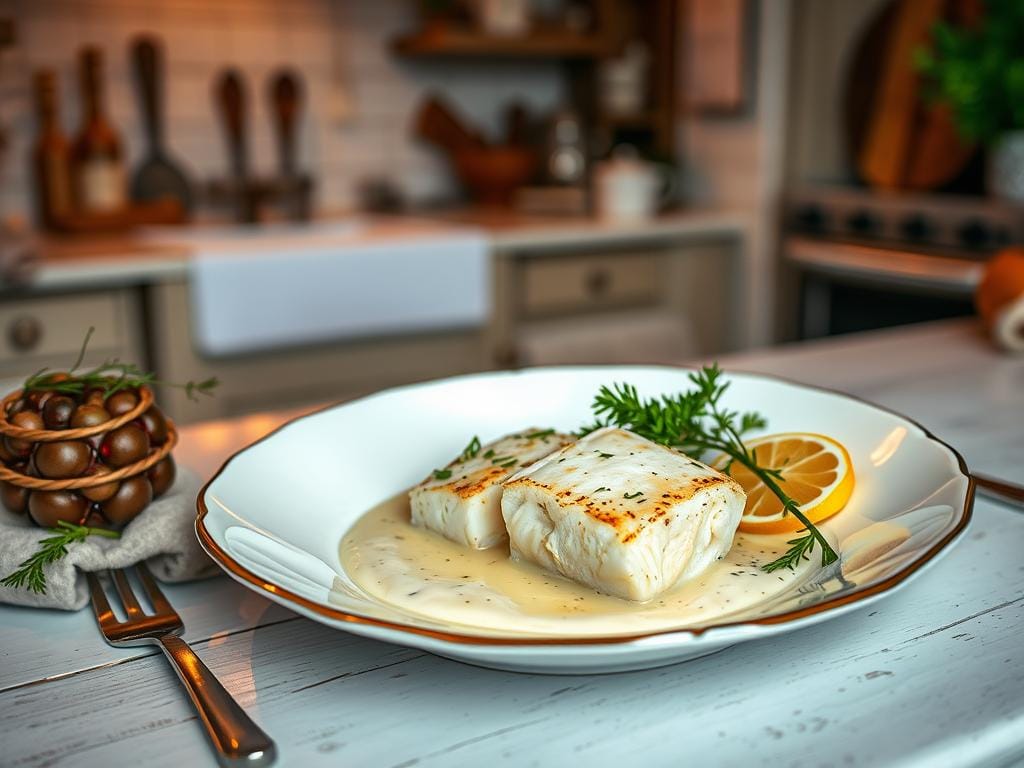Imagine finding a hidden treasure right under your nose. That’s what halibut cheeks are for seafood lovers. These delicate morsels turn an ordinary fish into an extraordinary meal. As a professional chef, I’ve seen many miss out on the amazing taste of succulent halibut pieces.
these tender fish cheeks are more than just another fish cut. They are a rare culinary gem, making up only 3-5% of a halibut’s weight. With more fat than traditional fillets, they offer a rich flavor that will take your seafood to new levels.
Enjoy quick and delicious seafood? Check out this guide on cooking Frozen Salmon in an Air Fryer!
Key Takeaways
- Halibut cheeks are a premium seafood delicacy often overlooked
- These morsels contain higher fat content for enhanced flavor
- Extremely limited availability makes them a unique culinary find
- Packed with protein and essential omega-3 fatty acids
- Sustainable seafood option from well-managed fisheries
Whether you’re a culinary adventurer or just love great seafood, cheeks are a must-try. They offer a taste experience that will change how you see fish forever.
What Makes Halibut Cheeks So Special
Explore the world of halibut cheeks, a seafood delight. These tender pieces are more than just fish – they’re a culinary adventure. They make your meals more enjoyable.
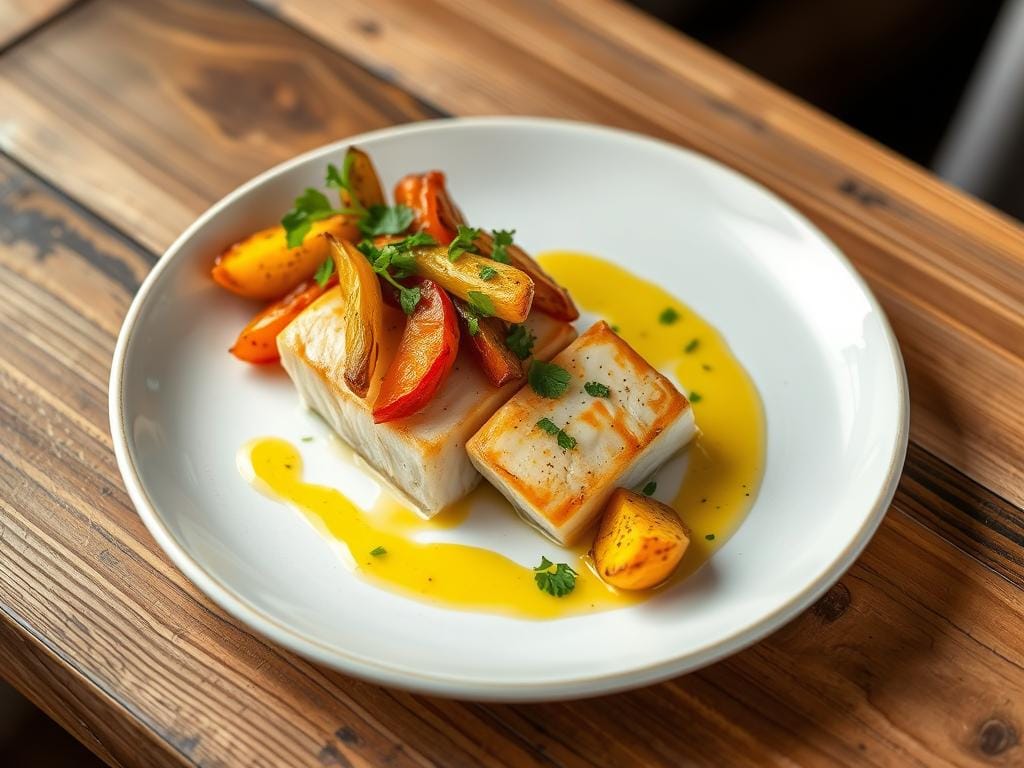
are the fish’s most tender and tasty part. They offer a unique taste experience. This is because they come from the fish’s most delicate spot.
The Natural Tenderness and Texture
Halibut cheeks stand out for their soft texture. They are:
- Incredibly soft and buttery
- Free from small bones
- Melt-in-your-mouth delicate
- Smooth with a subtle, sweet flavor
Nutritional Benefits Overview
the recipe not only tasty but also packed with nutrients. Each serving offers:
- Approximately 94 calories per 4-ounce serving
- 20 grams of high-quality protein
- Rich in omega-3 fatty acids (400 milligrams per serving)
- Exceptional source of Vitamin B12 (133% daily recommended intake)
- High selenium content (47% daily recommended intake)
Sustainable Seafood Choice
Choosing halibut cheeks is good for the planet. It supports eco-friendly fishing and reduces waste. These delicious cheeks are a sustainable seafood choice that’s good for you and the environment.
Pro tip: When selecting halibut cheeks, look for fresh, pearly white pieces with a clean, ocean-like aroma – a sign of their exceptional quality and freshness.
Essential Tips for Selecting Fresh
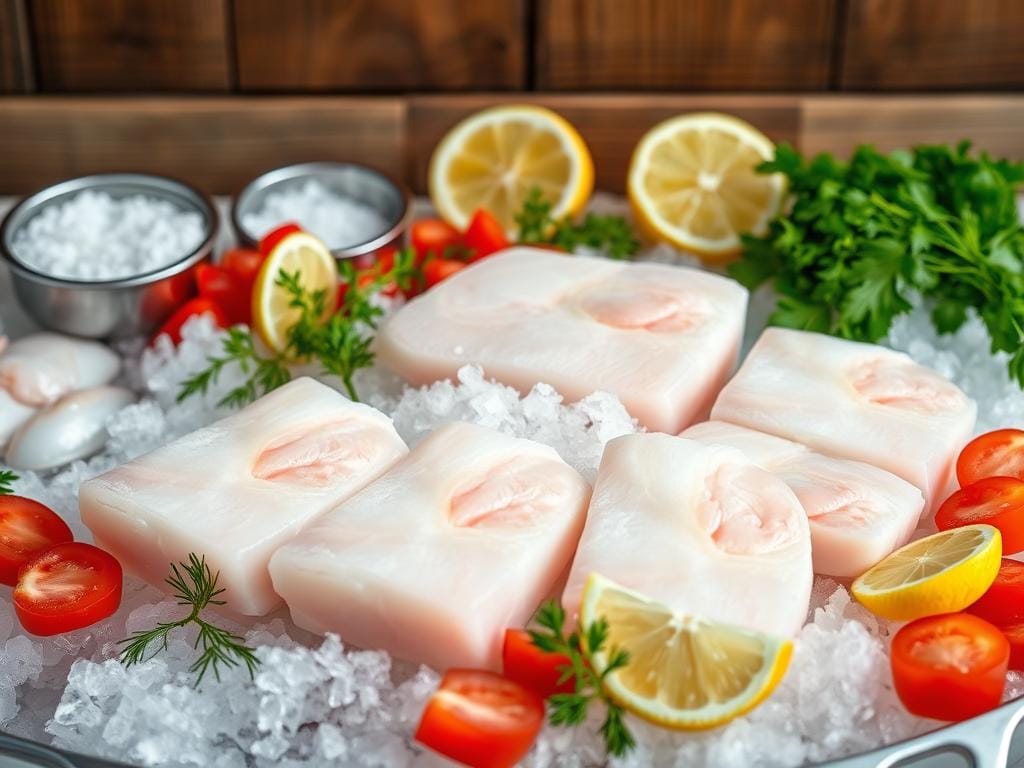
Choosing the right prodect can make your seafood meal better. These small pieces need careful picking to ensure they taste great. Knowing how to pick the best halibut cheeks will make every meal delicious.
When you’re looking for halibut cheeks, remember these important tips:
- Look for halibut cheeks with a clean, ocean-fresh smell
- Seek out halibut cheeks with a pearly white or slightly translucent appearance
- Check for firm, resilient texture without any discoloration
- Avoid halibut cheeks with a strong fishy odor
It’s important to store it right to keep them good. Put them in the fridge as soon as you get them. Use them within 1-2 days. If you can’t cook them right away, freezing is a great way to keep them fresh for up to three months.
When it comes to when to buy it, the season matters a lot. The best time is from March to November. During these months, you’ll get the freshest and tastiest halibut cheeks.
| Selection Criteria | Ideal Characteristics |
|---|---|
| Smell | Clean, ocean-fresh aroma |
| Appearance | Pearly white or translucent |
| Texture | Firm and resilient |
| Storage Life | 1-2 days refrigerated, 3 months frozen |
Pro tip: Buy from trusted seafood suppliers. They focus on quality and sustainable fishing. Global Seafoods and local fish markets are great places to find top-notch halibut cheeks.
The Perfect Preparation Methods
it needs careful steps to keep their flavor and texture perfect. These special seafood pieces need extra care to shine in your recipes.
Pan-Searing Techniques
Pan-searing is a top choice for cooking halibut cheeks. Here’s how to get a golden crust:
- Pat the it dry with paper towels
- Season with salt and pepper
- Heat olive oil in a skillet over medium-high heat
- Cook for 3-4 minutes per side until opaque
- Aim for a light golden-brown exterior
Baking and Broiling Options
Baking and broiling are great for a softer cooking method. Preheat your oven to 375°F and follow these steps:
- Place cheeks on a lightly greased baking sheet
- Sprinkle with herbs like thyme or parsley
- Bake for 10-12 minutes until fish is fully cooked
- Optional: Finish with a quick broil for crispy edges
Seasoning Recommendations
The secret to great recipes is using the right seasonings. Choose flavors that highlight their natural sweetness.
| Seasoning Type | Recommended Herbs/Spices |
|---|---|
| Citrus-Based | Lemon zest, fresh dill |
| Mediterranean | Oregano, garlic powder |
| Herb-Focused | Fresh parsley, chives |
Pro tip: Always use fresh, high-quality seasonings to complement the delicate flavor of halibut cheeks.
Simple Yet Delicious Recipe
Making a tasty delicate seafood is easy.
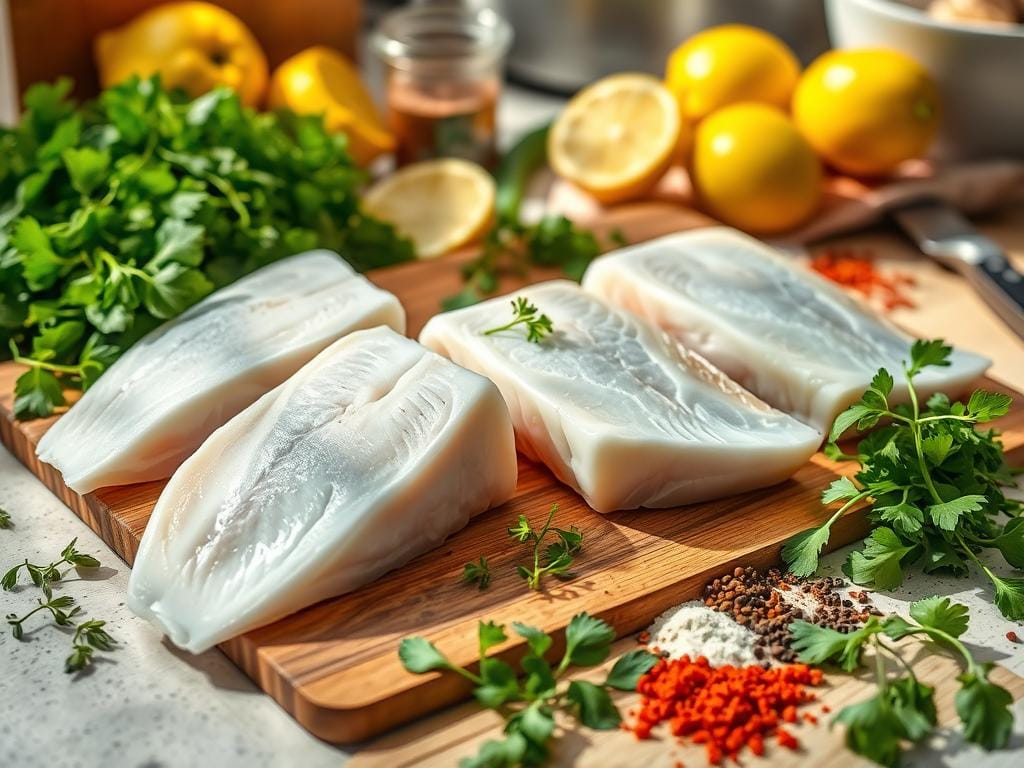
Ingredients
- 1 pound fresh halibut cheeks
- 2 tablespoons olive oil
- 2 tablespoons butter
- 2 garlic cloves, minced
- ½ cup chicken or vegetable broth
- Juice of 1 lemon
- Salt and pepper to taste
- 1 tablespoon chopped parsley for garnish
Step-by-Step Cooking Instructions
- Pat it dry with paper towels to ensure proper searing
- Season cheeks with salt and pepper
- Heat olive oil in a skillet over medium-high heat
- Cook halibut cheeks for 2-3 minutes per side
- Remove cheeks and set aside
- Add butter and garlic to the pan, sautéing briefly
- Pour in broth and lemon juice, creating a light sauce
- Return halibut cheeks to the pan to warm
- Garnish with chopped parsley
Nutritional Profile
| Nutrient | Per Serving |
|---|---|
| Calories | 313 kcal |
| Protein | 12g |
| Total Fat | 27g |
| Carbohydrates | 9g |
This these tender fish cheeks is quick and elegant. It’s ready in just 15 minutes, ideal for a busy weeknight. Pro tip: Serve it right away for the best taste and texture.
Storing leftovers is easy. Keep them in the fridge for up to 3 days. Reheat in the microwave in 20-second bursts to avoid overcooking.
Common Cooking Mistakes to Avoid
Cooking halibut cheeks needs precision and care. Even skilled home chefs can make mistakes. These mistakes can ruin what could be a delicious meal. Knowing how to cook your halibut cheeks can improve your seafood cooking.
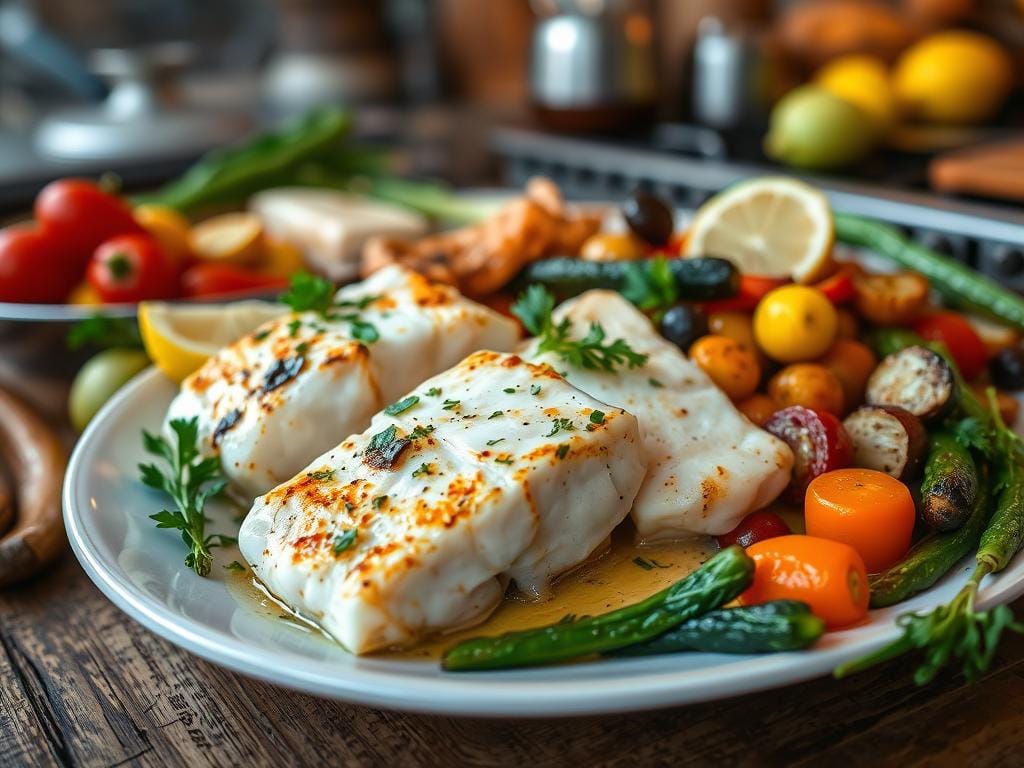
Temperature Control Challenges
Temperature is key when cooking halibut cheeks. These proteins can become tough and dry if not cooked right. The best internal temperature is between 130°F to 135°F. Cooking them too long can make them up to 50% tougher.
- Use a digital meat thermometer for precise readings
- Remove from heat when internal temperature approaches 125°F
- Let the halibut cheeks rest for 2-3 minutes after cooking
Seasoning Pitfalls
Your recipe should highlight their natural flavor. These cheeks taste sweet, like sea scallops. Don’t use too much seasoning that hides their taste.
- Use light, complementary seasonings
- Salt just before cooking
- Consider minimal herbs like dill or parsley
Timing Mistakes to Dodge
Halibut cheeks cook fast, in 2-4 minutes. Timing is everything. Overcooking can make them lose 25% of their moisture, turning them dry and tough.
- Cook for 4-5 minutes total
- Use high heat for quick searing
- Avoid overcrowding the cooking pan
Pro tip: Always pat your halibut cheeks dry before cooking. This ensures a perfect golden sear and keeps more flavor.
Pricing and Availability Guide
Knowing the price of halibut cheeks helps you make smart seafood choices. These fish pieces are a culinary gem with prices that show their special qualities.
Right now, halibut cheeks cost about $38.00 per pound. A 6 lb box is around $239.50. You can also buy 1 lb portions. Remember, prices change with the season and how well the fish are caught.
Where to Purchase Halibut Cheeks
- Specialty seafood markets
- High-end grocery stores
- Online seafood retailers
- Direct from Alaskan seafood suppliers
When looking for halibut cheeks, think about these important points:
- Wild-caught Alaskan sources are the best quality
- Look for individually vacuum-sealed packaging
- Check shipping and delivery options
- Make sure they handle the fish right
Shipping matters a lot. Many sellers offer free shipping for orders over 8 lbs. For smaller amounts, shipping costs about $75. Some even ship across the country, so you can get these premium seafood treats anywhere.
Pro tip: Buy during peak seafood seasons for the best prices and freshness. Wild Alaskan sources ensure 100% wild-caught, gluten-free options that fit keto and paleo diets.
Pairing Suggestions and Serving Ideas
Make your recipes shine with the right side dishes. Choose light, vibrant options that bring out the fish’s delicate flavor. This way, you won’t overpower the taste of these special fish pieces.
Here are some top pairing ideas for serving halibut cheeks:
- Lemon Herb Green Beans: Ready in under 30 minutes
- Cilantro Lime Slaw: Quick 10-minute prep
- Seasonal Autumn Harvest Salad with oranges and pomegranate
- Herby Pea Salad with zucchini and asparagus
- Air-fried Radishes for a modern twist
Your presentation is just as important as the flavors. For a casual dinner, serve on a rustic wooden board with vibrant sides. For a fancy event, arrange each dish neatly on individual plates.
Here are some tips to boost your halibut cheeks recipes:
- Try citrus-based sauces for a bright taste
- Add fresh herbs for depth
- Choose light, crisp veggies
- Make the plate colorful
Pro tip: Prep side dishes in 30 minutes or less. This keeps your meal fresh and in sync with the quick cooking time of halibut cheeks.
Conclusion
Exploring halibut cheeks is like finding a hidden treasure in seafood. These small pieces of fish are often ignored, but they offer a special taste and texture. They make your kitchen feel like a fancy restaurant.
Halibut cheeks are also great for your health. They are full of omega-3s, protein, and vitamins like B12 and magnesium. These nutrients help build muscles and keep you healthy. Plus, you can cook them in many ways, like grilling or baking.
Learning to cook halibut cheeks is easy but rewarding. It doesn’t matter if you’re a pro or just starting out. With the right techniques, you can make a dish that tastes like it came from a fancy restaurant.
Now that you know about halibut cheeks, it’s time to get creative. Try out new recipes and cooking methods. Enjoy the thrill of finding this special seafood. Your taste buds will love the journey!
FAQ
Q: What exactly are halibut cheeks?
A: Halibut cheeks are the tender meat near a halibut’s head. They are soft and have a delicate flavor. These small pieces are about the size of a silver dollar and are prized for their taste and texture.
Q: Are halibut cheeks expensive?
A: Yes, halibut cheeks can cost between to per pound. Their high price is due to their quality and limited availability. Prices change based on where they are caught and the season.
Q: How do I know if halibut cheeks are fresh?
A: Fresh halibut cheeks smell like the ocean and don’t have a strong fish smell. They should be white or slightly off-white and firm. Look for plump cheeks without any discoloration. Buying from a trusted fishmonger helps confirm freshness.
Q: What’s the best way to cook halibut cheeks?
A: Pan-searing is the top choice for cooking halibut cheeks. Use a little oil, season lightly, and cook for 2-3 minutes on each side. They can also be baked or broiled, but be careful not to overcook.
Q: Are halibut cheeks nutritionally beneficial?
A: Yes, they are! Halibut cheeks are packed with lean protein, omega-3s, and vitamins like B12 and selenium. They are low in calories and great for heart health and muscle support.
Q: How should I store halibut cheeks?
A: Keep them in the coldest part of your fridge, on ice, and use within 1-2 days. You can freeze them for up to three months. Wrap them tightly to prevent freezer burn.
Q: Can I use halibut cheeks in different recipes?
A: Definitely! Halibut cheeks are versatile. They’re great in fish tacos, seafood pasta, or with light sauces. Their delicate flavor makes them easy to adapt to many dishes.
Q: Are halibut cheeks a sustainable seafood choice?
A: Yes, they can be. Choose halibut caught with sustainable methods and look for certifications. Wild-caught Alaskan halibut is often a good choice for the environment.

